Wikipedia:Picture of the day/September 2008
|
Featured picture tools: |
These featured pictures, as scheduled below, appeared as the picture of the day (POTD) on the English Wikipedia's Main Page in September 2008. Individual sections for each day on this page can be linked to with the day number as the anchor name (e.g. [[Wikipedia:Picture of the day/September 2008#1]] for September 1).
You can add an automatically updating POTD template to your user page using {{Pic of the day}} (version with blurb) or {{POTD}} (version without blurb). For instructions on how to make custom POTD layouts, see Wikipedia:Picture of the day.
September 1

|
An animated image of a tablet press, a mechanical device that compresses powder into tablets of uniform size and weight. To form a tablet, the granulated material must be metered into a cavity formed by two punches and a die, and then the punches must be pressed together with great force to fuse the material together. Image credit: Jeff Dahl
Recently featured: |
September 2
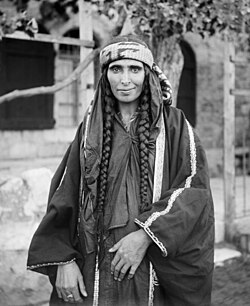
|
A Bedouin woman in Jerusalem, sometime between 1898 and 1914, dressed in Palestinian costume, the traditional clothing worn by Palestinians. Many of the handcrafted garments were richly embroidered and the creation and maintenance of these items played a significant role in the lives of the region's women. Until the 1940s, traditional Palestinian costumes reflected a woman's economic status, whether married or single, and the town or district of origin, and a knowledgeable observer could glean such information from the fabric, colors, cut, and embroidery motifs (or lack thereof) in a given woman's apparel. Photo credit: American Colony Photographers
Recently featured: |
September 3

|
|
An HDR panorama of Mont Blanc, as seen in the afternoon from the Rébuffat platform. Located between Aosta Valley, Italy, and Haute-Savoie, France, it is the highest mountain in the Alps and Western Europe and ranked 11th in the world in topographic prominence. Photo credit: Nicolas Sanchez
Recently featured: |
September 4
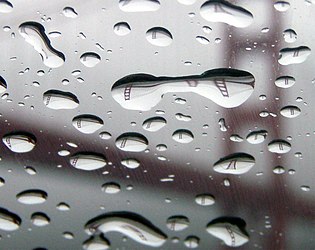
|
The Golden Gate Bridge in San Francisco, California, as refracted through rain drops on the window of an automobile, which act as lenses. In optics, refraction occurs when light waves travel from a medium with a given refractive index to a medium with another, whereupon the wave's phase velocity is altered, causing the wave to change direction; its wavelength increases or decreases but its frequency remains constant. Photo credit: Mila Zinkova
Recently featured: |
September 5

|
The Golden-mantled Ground Squirrel (Spermophilus lateralis) is a species of squirrel native throughout North America and can be found in a wide variety of forest habitats as well as rocky meadows, and even sagebrush flats. It can be identified by its chipmunk-like stripes and coloration, but unlike chipmunks, it lacks any facial stripes. Photo credit: Eborutta
Recently featured: |
September 6

|
A buff-tailed bumblebee (Bombus terrestris), a very common species in southern Europe, robbing nectar, which is when an animal collects nectar from a flower without pollinating it. The bee uses its long and slender tongue to reach the space between the flower's sepal and corolla. These bees form annual colonies of which only mated queens survive the winter. Photo credit: Joaquim Alves Gaspar
Recently featured: |
September 7

|
The Casa Milà, a 1912 work by Catalán architect Antoni Gaudi, in the Eixample district of Barcelona, Spain. Gaudí's fascination with trencadís-influenced decoration and curves (predating biomorphism by almost 20 years) can be seen here. Photo credit: David Iliff
Recently featured: |
September 8

|
The Green Violetear (Colibri thalassinus) is a hummingbird that is a resident breeder in highlands from south-central Mexico, (the Trans-Mexican Volcanic Belt), to western Panama and in the Andes from northern Venezuela to Bolivia. It shows seasonal movements and wanders to the United States and even Canada. Photo credit: Mdf
Recently featured: |
September 9
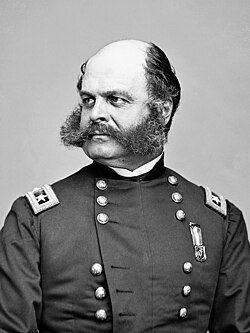
|
Ambrose Burnside was an American soldier, railroad executive, inventor, industrialist, and politician from Rhode Island, serving as governor and a U.S. senator. As a Union Army general in the American Civil War, he conducted successful campaigns in North Carolina and East Tennessee but was defeated in the disastrous Battle of Fredericksburg and Battle of the Crater. His distinctive style of facial hair is now known as sideburns, derived from his last name. Photo credit: Mathew Brady
Recently featured: |
September 10

|
A map of Gibraltar, a British overseas territory located near the southernmost tip of the Iberian Peninsula overlooking the Strait of Gibraltar. The territory shares a border with Spain to the north. Gibraltar has historically been an important base for the British Armed Forces and is the site of a Royal Navy base. Map credit: Eric Gaba/Jeff Dahl
Recently featured: |
September 11

|
A New York City Fire Department firefighter calls for ten more rescue workers to make their way into the rubble formed by the collapse of the World Trade Center in the aftermath of the September 11, 2001 attacks. Photo credit: Journalist 1st Class Preston Keres, United States Navy
Recently featured: |
September 12
|
A 360° panorama taken during the descent from the summit of Husband Hill, one of the Columbia Hills in Gusev crater, Mars. This stitched image is composed of 405 individual images taken with five different filters on the panoramic camera over the course of five Martian days. Photo credit: Spirit rover
Recently featured: |
September 13

|
A playboating contestant at Paddle for the People, July 2007, in Manchester, New Hampshire, USA. Playboating is a discipline of whitewater kayaking or canoeing where the paddler performs various technical moves in one place (a playspot), as opposed to downriver whitewater canoeing or kayaking where the objective is to travel the length of a section of river. Photo credit: Mike Spenard
Recently featured: |
September 14

|
Vindula arsinoe, commonly known as the "cruiser", is a day butterfly from the family Nymphalidae. It ranges from New Guinea to the Solomon Islands. Photo credit: Benjamint444
Recently featured: |
September 15
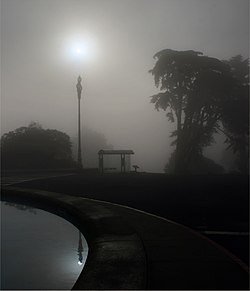
|
Parallax causes the reflection of the sun in the water to appear directly behind the street light, even though it appears much higher than the light in the sky. The location of the virtual image is below the surface of the water and thus simultaneously offers a different vantage point of the street light, which appears to be shifted relative to the stationary, background sun. Photo credit: Mila Zinkova
Recently featured: |
September 16

|
A flagellum is a long, slender projection from the cell body, whose function is to propel an organism. The depicted type is found in bacteria such as E. coli and Salmonella, and rotates like a propeller when the bacterium swims. Image credit: Mariana Ruiz
Recently featured: |
September 17

|
The New England Tree Frog (Litoria subglandulosa) is a species of frog native to the streams of the New England Tablelands, New South Wales, Australia. Photo credit: LiquidGhoul
Recently featured: |
September 18
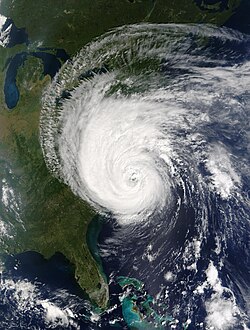
|
The eye of Hurricane Isabel making landfall at North Carolina's Outer Banks on September 18, 2003. This Category 5 hurricane was the costliest and deadliest in the 2003 Atlantic hurricane season. It quickly weakened over land and became extratropical over western Pennsylvania the next day. Moderate to severe damage extended up the Atlantic coastline and as far inland as West Virginia. Throughout the path of Isabel, damage totaled about $3.6 billion (2003 USD, $4.1 billion 2008 USD). Sixteen deaths in seven U.S. states were directly related to the hurricane, with 35 deaths in six states and one Canadian province indirectly related to the hurricane. Image credit: MODIS
Recently featured: |
September 19

|
The Kentish Plover or Snowy Plover (Charadrius alexandrinus) is a small wader in the plover bird family. Despite its name, this species no longer breeds in Kent, or even Great Britain. Instead, it breeds in most subtropical and tropical parts of the world. Photo credit: Mike Baird
Recently featured: |
September 20

|
Brevet Major General George Armstrong Custer of the United States Army, seated, in field uniform, 1865. Custer, an officer and cavalry commander in the American Civil War and the Indian Wars, had a reputation as an aggressive commander willing to take personal risks by leading his Michigan Brigade into battle. He was defeated and killed at the Battle of the Little Bighorn in 1876, against a coalition of Native American tribes, an event popularly known in American history as "Custer's Last Stand". Photo credit: George L. Andrews
Recently featured: |
September 21

|
The traditional clothing of the Māori can be seen in this engraving of a meeting between Māori and settlers in Hawke's Bay Province during the Invasion of Waikato in 1863. Muka, the fibre of New Zealand flax, was the basis of most clothing. Illustration credit: M. Jackson, Illustrated London News
Recently featured: |
September 22

|
A European paper wasp (Polistes dominula) heating a bubble of regurgitated fluid in the sunlight. This is a common practice among many winged insects, and it is believed to be a way to facilitate digestion or to cool themselves off. Photo credit: Joaquim Alves Gaspar
Recently featured: |
September 23

|
The Justine McAllister, a tugboat, in New York Harbor. Tugboats are used to maneuver, primarily by towing or pushing, other vessels in harbors, over the open sea or through rivers and canals. Tugboats are also used to tow barges, disabled ships, or other equipment like towboats. Photo credit: Eric Baetscher
Recently featured: |
September 24

|
Grand Central Terminal in Midtown Manhattan, New York City, is the largest train station in the world by number of platforms: 44, with 67 tracks along them. It is commonly referred to as "Grand Central Station", which is the name of the nearby post office as well as a previous rail station on the site. Photo credit: Eric Baetscher
Recently featured: |
September 25

|
|
The River Thames in London at sunset, with the Tower Bridge and London skyline in the background. While best known because its lower reaches flow through central London, the Thames flows 215 miles (346 km) across southern England. The river gives its name to the Thames Valley, a region of England centred around the river between Oxford and west London, the Thames Gateway, the area centred around the tidal Thames, and the Thames Estuary to the east of London. Photo credit: David Iliff
Recently featured: |
September 26

|
A daguerreotype of San Francisco, California in 1850 or 1851 during the height of the California Gold Rush. Merchant sailing ships crowd San Francisco Bay and Yerba Buena Island can be seen in the background. During this time, the harbor would become so crowded that ships often had to wait days before unloading their passengers and goods. Photo credit: Unknown
Recently featured: |
September 27

|
A pre-Mercator nautical chart of West Africa from 1571, by Portuguese cartographer Fernão Vaz Dourado. It is done using the so-called "plane chart model", where observed latitudes and magnetic directions were plotted directly into the plane, with a constant scale, as if the Earth were flat. Map credit: Fernão Vaz Dourado
Recently featured: |
September 28
|
A 300° panorama of the baggage claim area of Hong Kong International Airport. Air passengers collect their checked-in luggage from the baggage carousels before exiting the airport terminal. In areas handling international arrivals, the baggage claim is typically located after immigration control and before customs, so that all baggage can be inspected by customs agents, but the passenger does not have to handle heavy baggage while moving through the passport booth. Photo credit: Samuel Louie
Recently featured: |
September 29

|
Buzz Aldrin gets equipment out of the SEQ bay of Eagle, the Apollo 11 Lunar module (LM). The LM was the lander portion of the Apollo spacecraft built for the Apollo program by Grumman to achieve the transit from cislunar orbit to the surface and back. After the Apollo 11 astronauts returned from the moon, Eagle was left in lunar orbit and eventually crashed on the surface of the moon. Photo credit: Neil Armstrong
Recently featured: |
September 30
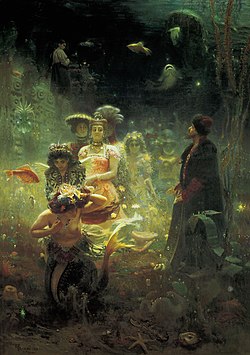
|
Sadko in the Underwater Kingdom, a painting by Ilya Repin depicting Sadko, a Russian folk hero of a bylina of the same name, though this painting depicts only one specific version of that tale. In this version, the Sea King wants Sadko to marry one of the many underwater beauties (daughters). However, if he chooses one of them he will remain under the sea forever. Instead he is supposed to pick an unremarkable servant girl -- pictured in the upper left hand side -- who will magically help him return to Novgorod and his human wife there. The story inspired both an opera and musical tableau. Artist: Ilya Repin
Recently featured: |
Picture of the day archives and future dates


